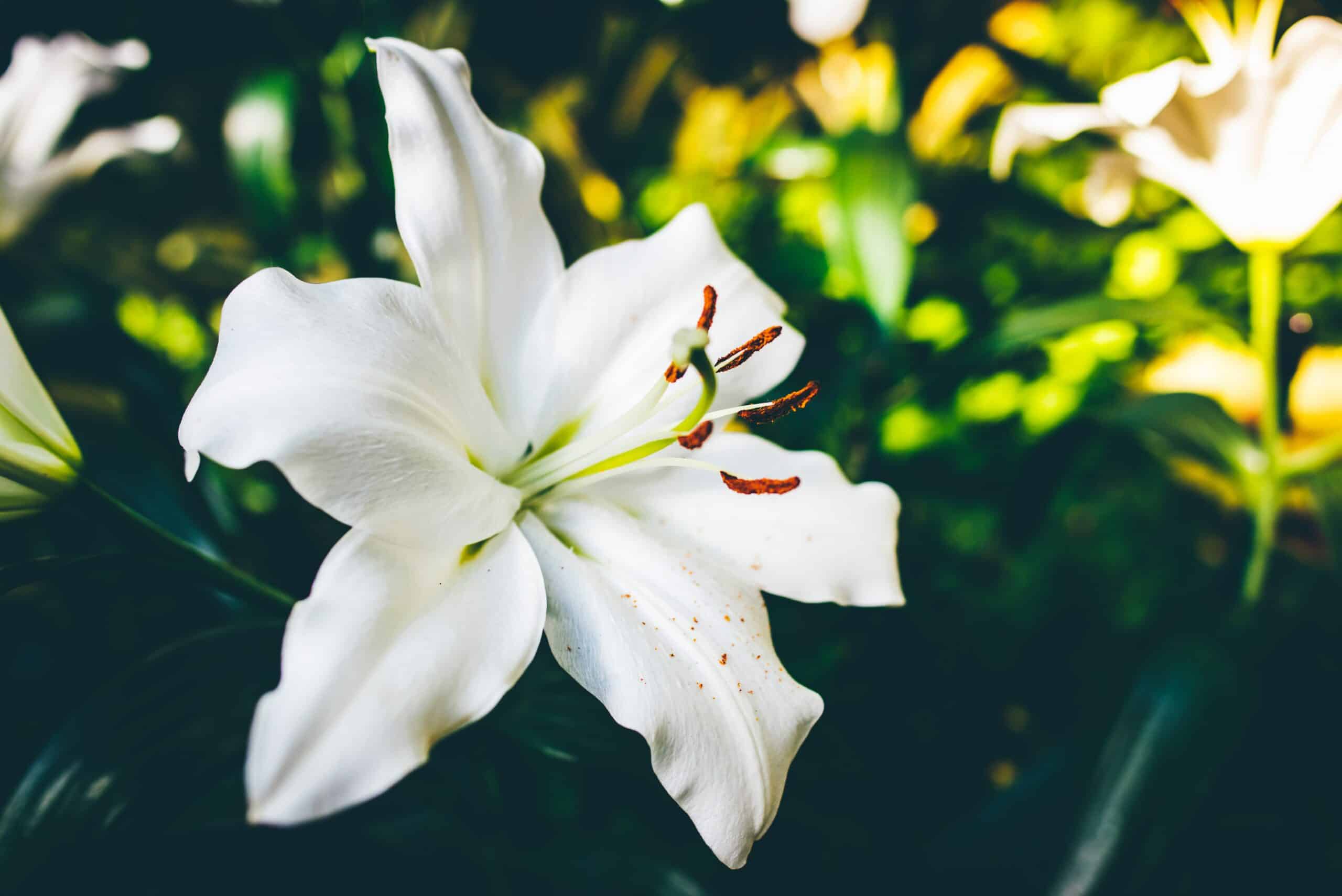The calla lily is a beautiful, elegant flower with a distinct shape and texture that captures the attention of onlookers. With its vibrant colors and soft petals, it can add a touch of beauty to any environment. While growing and caring for calla lilies can be difficult, it is not impossible.
With the right preparation and knowledge, anyone can have a healthy and beautiful calla lily in their home or garden. You just need to know the basics of how to grow and care for these flowers. This article will provide you with all the information you need about growing and caring for calla lilies indoors so that you can enjoy them year-round.
By following simple steps like proper watering, fertilizing, and pruning techniques, you will be able to ensure that your calla lilies remain healthy and vibrant for years to come. So whether you are a beginner gardener or an experienced green thumb looking for tips on how to get the best out of your calla lilies, this article has everything you need to make sure that your plants stay healthy and beautiful indoors.
Choose A Quality Calla Lily Bulb
Planting a calla lily is like planting a dream – one that will blossom into a stunning sight of iridescent beauty. When it comes to getting the best out of this lovely flower, choosing the right bulb is essential.
First off, when you go to buy your calla lily bulb, make sure you’re getting one from a reputable dealer. The bulbs should be firm and heavy for their size and free from any signs of damage. If possible, check for any visible sprouts or roots before you buy them as this indicates freshness. You can also store your bulbs in a cool and dry place for up to two months until you’re ready to plant them.
It’s also important to note that calla lilies need well-draining soil that’s rich in organic matter. Make sure the pot or container you choose has adequate drainage holes; otherwise the soil can become waterlogged which can lead to root rot and other problems with the plant’s health.
It’s time to get planting! Soil preparation is important if you want your calla lily to thrive indoors over time – so make sure your soils are fit for purpose before introducing your precious new bulb into its forever home.
Prepare The Soil For Planting
Planting a calla lily is an exciting prospect for those who wish to enjoy its beauty in the comfort of their own home. To ensure success and a healthy flower, there are several steps that must be taken before placing the bulb in the soil. Just like any other plant, quality soil preparation is essential for growth and longevity.
Creating quality soil begins with selecting a pot that allows ample space for the roots to grow. A well-draining potting mix should provide necessary nutrients to keep the calla lily healthy. It is also important to add some organic material, such as compost or peat moss, to improve drainage and aeration while maintaining moisture levels. Additionally, you can fertilize the soil during the growing season using an all-purpose fertilizer according to package directions.
Once you have established your planting area and soil composition, it’s time to make sure it is ready for planting by testing for pH levels. The ideal pH level for calla lilies is 6.0-6.7; if your soil’s pH falls outside of this range, you will need to adjust it accordingly with lime or sulfur before planting your bulb. With proper care and attention, your calla lily will soon be on its way to providing beautiful blooms throughout its life cycle!
Plant The Bulb In A Container
With the right potting materials and soil, you can get your Calla Lily planted in no time. Planting is an easy task that anyone can do with a few simple steps.
First, find a suitable container for your plant. It should have ample drainage holes at the bottom to allow excess water to escape after watering. Consider using a terracotta pot for better aeration of the soil and roots. Fill the pot with well-draining potting mix or soil that is rich in organic matter, such as compost or peat moss. The soil should be moist but not soggy when planting the bulb.
Next, position the bulb in the center of the container and gently push it into place until it’s firmly seated in the soil. The top part of the bulb should be visible above the surface of the soil, and make sure not to bury it too deep as this may cause rot or disease. Cover up any exposed parts of the bulb with more soil and lightly tamp down around it to secure it in place.
Now that you’ve got your Calla Lily planted, all you need to do is provide proper sunlight and water for optimal growth—two essential components for healthy plants!
Provide Proper Sunlight
Once you have planted the bulb in a container, it’s now time to provide proper sunlight for your calla lily. Allowing your plant to get adequate light is essential for it to thrive and reach its full potential. This can be done by placing the container close to a sunny window or under growing lights. If you choose to use artificial lights, make sure they are set up at least 12” away from the top of the plant and keep them on for 10-12 hours per day. You could even move the pot outdoors during the summer months, but remember to bring it back indoors when temperatures drop below 50 degrees Fahrenheit.
When providing sunlight, it’s important to pay attention to how much light your calla lily is getting as too little or too much exposure can cause damage or death. If the leaves start turning yellow or brown, that means your plant isn’t getting enough light whereas if its leaves turn reddish-brown, then that means there is too much sun exposure. To ensure optimal growth, adjust your lighting accordingly.
With proper sunlight in place, your calla lily will now need regular watering in order for it to stay healthy and bloom properly.
Water The Plant Regularly
Watering the plant is like giving it a drink of life, so it’s essential to do regularly for successful growth. Just as we need to stay hydrated, plants need water to thrive. The trick with calla lilies is knowing when and how much water to give them.
Similar to people, plants have different needs in terms of hydration. Too little and they can become dehydrated; too much and they can drown—both of which can be fatal! A great way to test if your calla lily needs water is by checking the soil. If it feels dry, it’s time for a drink.
On average, you should water your calla lily once a week or every seven days. But depending on the conditions in your home, you may need to water more or less frequently. Keep an eye out for signs that the plant needs more moisture such as wilting leaves or brown spots on the foliage, and adjust accordingly. Providing adequate care will help your calla lily bloom at its best!
Feed The Calla Lily
Feeding your calla lily is an important part of its care. With the right nutrition, your plant will be healthy and grow in beautiful bloom. So let’s learn how to properly feed our beloved calla lily!
First, you’ll need to fertilize your plant every two weeks in spring and summer. Use a liquid fertilizer with balanced nutrients. During the fall and winter months, only fertilize once a month. This will ensure that your calla lily gets all the nutrients it needs without overfeeding it.
Make sure to avoid getting fertilizer on the leaves and stems of the plant as this can burn them. Water the soil before applying fertilizer so that it can be absorbed more easily, and then water again after application to help it absorb into the soil further. By following these simple steps, you will have a happy and healthy calla lily in no time!
Proper fertilization is key for optimal plant growth. With regular feeding and watering, you can help your calla lily reach its full potential of beauty and life. Now that we’ve taken care of feeding, let’s look at how to properly monitor the temperature for our lovely flower!
Monitor The Temperature
Picture a lush, sunny garden with calla lilies in full bloom and the vibrant colors of their petals radiating in the sunlight. Now imagine the warmth of that summer day, and how crucial it is to maintain a consistent temperature for these delicate flowers. That’s why monitoring the temperature is an essential seventh step in growing and caring for calla lilies.
Too much heat can inhibit growth and cause them to wilt or die, while too much cold can cause the plant to go dormant. To ensure that your calla lily thrives, you should keep the temperature between 65-75 degrees Fahrenheit during the day and 55-60 degrees Fahrenheit at night. You can also use a fan to increase air circulation and prevent any heat damage from occurring.
These steps will help you provide your beautiful calla lily with all of its needs so that it can reach its fullest potential. By carefully monitoring the temperature both during the day and at night, you’ll ensure that your calla lily stays healthy and happy all year round! With these tips, you’ll be able to enjoy your own lovely blooms before long.
Propagate Calla Lilies
Propagating calla lilies is a great way to ensure their beauty blooms across generations. Like growing a flower garden, it’s a labor of love that will bring joy for years to come. To do this, you need to be both gentle and diligent in your approach.
An anachronism to bear in mind is the concept of ‘nurture over nature’: working with what you’re given is essential for propagation success. Start by carefully lifting the base of the lily from its pot — as if you were digging up a treasure — and gently untangle the roots from one another, wrapping them in burlap or newspaper as you go. With a sharp knife, divide the root ball into two pieces and remove any dead material between them.
Replant each piece so that the calla lily can continue to thrive and spread its beauty for years to come. Taking care when propagating calla lilies will help ensure they remain healthy and beautiful, allowing others to enjoy their majesty as well. As such, it’s important to pay attention while dividing the plant — using caution and precision — as this process can determine whether or not your hard work will ultimately pay off.
Divide The Plant
Divide the plant to propagate calla lilies—the final step in successfully growing and caring for this beautiful flower. To do this, gardeners must have a sharp knife at the ready and be prepared to separate the root ball into multiple parts. Like peeling an onion, each layer reveals more potential new plants. With careful and deliberate actions, you can create a bounty of blooms with just one single calla lily.
Here are four tips for dividing the plant correctly:
- Cut away any dead or rotting leaves or stems
- Carefully slice through the root ball with a sharp knife
- Gently tease apart the roots
- Replant each division in fresh potting soil
Dividing a calla lily is satisfying work that yields many rewards. It’s also an opportunity to pay closer attention to your existing plants and make sure they’re healthy and thriving. By taking steps now to ensure your current calla lily is in good condition, you’ll be able to enjoy even more blooms from new divisions in the future!
Repotting The Calla Lily
It is commonly thought that repotting a calla lily can be difficult and time consuming. However, with proper care and knowledge, it can be an easy process that will help your calla lily thrive. To repot your calla lily, you’ll need:
• A pot or container with drainage holes • High-quality potting mix • Water-soluble fertilizer • Gloves to protect hands from any thorns on the plant
Begin by preparing the new pot. Fill it halfway up with the potting mix and then add a water-soluble fertilizer according to the directions on the package. Be sure to wear gloves if necessary when handling the lily and its thorns! Gently remove your calla lily from its previous container, taking care not to damage its roots. Place the rootball into the new pot and fill in around it with more of the potting mix. Add water until it begins draining out of the bottom of the pot, then empty out any excess from the saucer underneath.
Your calla lily should now be ready to be placed in indirect light and watered weekly or as needed. When you water your plant, make sure to avoid getting any water on its leaves as they are delicate and sensitive to moisture. Additionally, keep an eye out for pests such as mealybugs or fungus gnats as these can damage your plant if left untreated. With a little bit of care, your calla lily will continue looking beautiful all year round!
Watch For Pests And Disease
Just when you thought you had your calla lily care routine down to a science, you’ll need to watch out for pesky insects and diseases that can damage it. It’s like the saying goes – “it’s always something” – and the same applies to maintaining your calla lily. Here’s what you need to know:
First off, inspect the plant regularly for any signs of disease or pests. Check both the leaves and stems for discoloration, holes or other damage. If there are any changes, act quickly. You should also look out for whiteflies, spider mites and mealybugs; all of which can cause damage to your lily if left untreated.
Second, remove any damaged leaves from the stem immediately. This will help prevent further spread of any illnesses or infestations. Thirdly, use a pesticide or insecticidal soap if needed to control pests but avoid using chemical sprays unless absolutely necessary as they can harm beneficial insects in your garden. Finally, ensure proper air circulation around the plant by spacing it away from other plants in your home or garden.
Taking some extra time now to watch for pests and disease will save you a lot of trouble later on. By following these steps carefully you can have a healthy calla lily that will be beautiful addition to your home or garden!
Deadhead The Flowers
Deadheading calla lilies is an important part of caring for them. As the plant blooms, taking off spent flowers will help keep it looking its best and encourage new growth. It’s also a great way to enjoy the beauty of these flowers up close.
To deadhead your calla lilies, simply use scissors or pruners to snip off the flower head at its base. Make sure you get right down to the stem so that there is nothing left behind. This will keep your plant healthy and encourage new growth so that you can continue to enjoy its beauty throughout the season.
In addition, deadheading removes any seed heads which can spread unwanted weeds in your garden. It also helps to promote air circulation around the plant and prevent diseases from appearing in the future. With regular deadheading, you can ensure that your calla lilies look their best all year round!
By following these simple steps, your calla lilies will thrive and be a beautiful addition to any home or garden. Now let’s look at how to dig and store the bulbs for overwintering or replanting later on.
Digging And Storing The Bulbs
Digging and storing the calla lily bulbs is an important step in ensuring your plants thrive. To do this, you’ll need to wait until the foliage has died back and the flowers have faded. Once this has happened, you should begin digging up the bulbs. Make sure to use a spade or a trowel and take care not to damage them, as it’s essential for their health.
Once you’ve excavated them, you’ll want to brush off any excess dirt and leave them out in a warm place for about half an hour. This will allow any remaining moisture to evaporate from the bulbs and make them easier to store. After this, you should wrap each bulb in newspaper or paper towels before placing them in a plastic bag or container that is filled with peat moss, vermiculite, or sawdust.
Finally, store your calla lily bulbs in a room that maintains temperatures between 40–50 degrees Fahrenheit (4-10°C). This will keep them dormant until it’s time for replanting in springtime. With proper care and attention, these beautiful flowers are sure to come back year after year!
Caring for calla lilies during winter months is essential if they’re going to make it through the colder months successfully.
Caring For Calla Lilies In Winter
While calla lilies are beautiful all year round, winter can present some challenges to growing these plants. To ensure that your calla lilies thrive during the colder months, there are a few things you need to keep in mind.
First and foremost, you’ll want to make sure that your calla lilies have access to plenty of sunshine, as this will help them stay healthy. If this isn’t possible, you may want to consider investing in some grow lights or a sun lamp to supplement the natural light they receive. Additionally, it’s important to make sure the temperature in their environment remains above freezing.
It’s also important that you water your calla lilies regularly during the winter months. You should check the soil every few days and water when it starts to feel dry. Make sure not to over-water them though, as this can lead to root rot and other problems. Additionally, fertilizing your calla lilies at least once a month during winter will help them stay healthy and strong throughout the season.
With these tips in mind, you’re ready for the next step: troubleshooting common problems with your winter care routine for calla lilies!
Troubleshooting Common Problems
Troubleshooting common problems with your calla lily is a critical step towards keeping it healthy and happy. But sometimes, no matter how much you might love and care for your flower, it can still develop issues. Luckily, there are a few things you can do to help prevent or fix potential problems.
First off, keep an eye out for signs of disease or pests. These include yellowing leaves or spots on the foliage, wilting flowers and stems, and even small bugs crawling around the plant. If you see any of these signs, take immediate action by spraying the plant with an insecticidal soap or neem oil solution to get rid of any unwanted guests.
Additionally, make sure your calla lily is getting enough light and water. Too little light will cause the blooms to fade quickly, while too much water can lead to root rot. Try to keep the soil evenly moist but not soggy – this will help ensure it gets just the right amount of hydration without becoming oversaturated. Here’s a quick checklist of tips for troubleshooting:
• Check for pests or diseases regularly • Make sure your calla lily is getting enough light • Keep the soil evenly moist but not soggy • Fertilize about once every two months during its active growing season • Move it away from drafty areas that could cause cold damage in winter
By taking proactive steps and following these simple guidelines, you’ll be able to give your calla lily the best possible care so it can thrive in its indoor environment! With regular maintenance and preventive measures in place, you’ll be able to enjoy its beauty for years to come.
Frequently Asked Questions
What Is The Ideal Temperature For A Calla Lily?
Growing a calla lily indoors can be a great way to add some color and life to any room. But one of the most important things to consider when caring for your plant is its temperature needs. So, what is the ideal temperature for a calla lily? Let’s take a look.
When it comes to temperature, calla lilies prefer the mild warmth that you’d find in most homes. Ideal temperatures range from 65°F to 75°F (18-24 °C). If you keep them outside during the warmer months, just make sure that they are not in direct sunlight and that temperatures don’t drop below 55°F (12 °C) at night. You may want to bring them inside if you live in an area that gets very cold or experiences extreme temperatures.
With proper temperature control, your calla lilies will thrive! They’ll reward your effort with beautiful flowers – and no need to worry about the frosty chill of winter affecting their growth! To ensure your plants stay healthy and happy, make sure they get plenty of water and fertilizer as well. With some dedication and care, you can enjoy growing these stunning plants indoors all year round!
What Is The Best Type Of Soil To Use For Calla Lilies?
Growing and caring for calla lilies doesn’t have to be a difficult task. In fact, with the right soil, these beautiful flowers can thrive in any home. Let’s explore what type of soil is best for calla lilies so you can get the most out of your plants.
When it comes to selecting soil for your calla lilies, there are a few things to keep in mind. First and foremost, you’ll need to find a potting mix that ensures good drainage while retaining enough moisture. This means selecting something that offers ample aeration as well as adequate water retention capabilities. Here are a few elements to look out for:
- A balance of organic matter such as peat moss or composted bark
- Perlite or vermiculite to provide proper aeration
- Sand for improved drainage
- Fertilizer that is rich in potassium and phosphorus
These components combined will help you create a nutrient-rich environment where the roots of your calla lily can take hold and flourish. Additionally, make sure the soil pH is between 5 and 7, which will further promote healthy growth. It’s also important to use fresh soil each time you repot your plant; this helps ensure optimal health by preventing disease buildup from last season’s soils and fertilizers.
So go ahead – get creative with your potting mix! With careful consideration when it comes to choosing the right type of soil, you’ll give yourself the best chance at cultivating vibrant, beautiful calla lilies in no time!
How Often Should I Water A Calla Lily?
It’s often a surprise to discover just how often we need to water our plants. With calla lilies, the answer is relatively simple: they should be watered regularly and adequately. As with many plants, regular watering will help keep them healthy and looking their best.
So, what does ‘regularly’ mean? Generally speaking, it’s best to water calla lilies once a week or so, making sure that the soil is evenly moist but not soggy. To test for moisture levels, stick your finger into the soil up to your first knuckle; if you feel dampness, then you can wait a few days before watering again. It’s also important to note that if you’re growing your calla lilies indoors near a window or other source of heat, they may need more frequent watering in order to prevent dehydration.
When it comes to caring for calla lilies—or any houseplant—it pays off to invest some time in understanding its unique needs. By taking the time up front to familiarize yourself with your plant’s watering requirements (as well as other care tips), you can ensure that your calla lilies remain healthy and vibrant for many years down the road!
How Can I Tell When My Calla Lily Needs To Be Repotted?
Like a majestic swan, the calla lily stands tall and proud in its pot. It’s an eye-catching beauty that not only adds vibrancy to your home, but is also surprisingly easy to care for. But with proper care comes knowing when it’s time to repot your calla lily – and that’s what this article will help you figure out!
It’s important to recognize when your calla lily has outgrown its pot. Over time, the plant’s roots may become cramped or matted, resulting in yellowing leaves and wilting stems. Once you notice these signs, it’s likely time to give your calla lily some extra space so it can thrive.
When repotting your calla lily, use a slightly larger pot than before with fresh soil and good drainage. Make sure the pot has ample space for the roots of the plant and provide plenty of indirect sunlight for optimal growth. With consistent watering and a little fertilizer every few weeks, you’ll be able to properly tend to your calla lily so it can reach its full potential!
So if you’re looking for a beautiful addition to any room in your home that requires minimal effort on your part, look no further than the elegant calla lily! With proper care and attention, you can ensure that this lovely flower continues to bloom beautifully year after year.
Are Calla Lilies Toxic To Pets?
Are calla lilies toxic to pets? This is an important question to answer if you’re considering growing these beautiful flowers inside your home. After all, safety comes first, especially when it comes to our beloved four-legged friends! Thankfully, the good news is that calla lilies are not toxic to cats or dogs.
However, as with most plants, it’s best to keep them out of reach of curious furry friends. Calla lilies contain calcium oxalate crystals that can cause mild stomach upset and vomiting if ingested in large amounts. Additionally, some of the plant’s pollen can irritate sensitive noses and throats if inhaled too deeply.
It’s important to keep in mind that although calla lilies are non-toxic for cats and dogs, their leaves can still cause injury if chewed or eaten in large quantities. To prevent any potential issues, be sure to monitor your pet around the calla lily plants and discourage them from nibbling on any part of the plant. By taking precautionary measures like these, you can ensure everyone (including your pet!) enjoys the beauty of this captivating flower safely and responsibly!
Conclusion
The calla lily is a stunning flower that is sure to bring beauty and grace to any home or garden. It can be a challenging plant to grow and care for, but with the right knowledge, one can truly nurture these gorgeous blooms. By understanding the ideal temperature, soil type, watering frequency, and when it needs to be repotted, your calla lilies will be thriving in no time. Furthermore, you can rest easy knowing that these stunning blooms are not toxic to pets so your furry friends can also enjoy their beauty. In short, caring for a calla lily is a labor of love – they require patience and attention to detail, but the rewards are well worth it! The vibrant colors of the petals and their graceful form create an atmosphere of sheer beauty that will astound anyone who beholds them. If you’re looking for something special in your garden or home this season then look no further than the majestic calla lily!





























